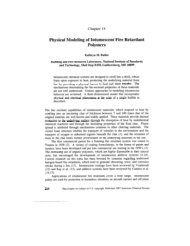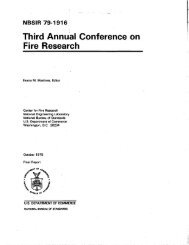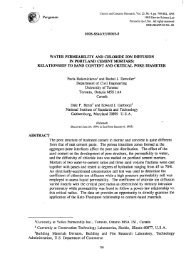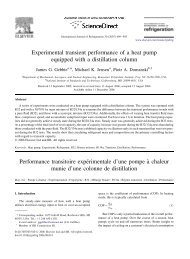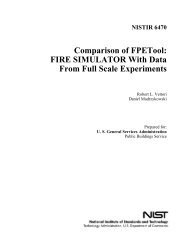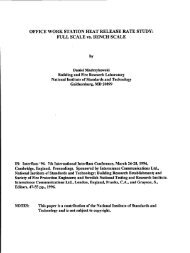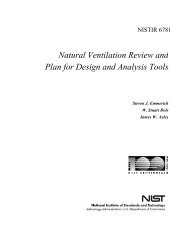Study of Technology for Detecting Pre-Ignition Conditions of ... - NIST
Study of Technology for Detecting Pre-Ignition Conditions of ... - NIST
Study of Technology for Detecting Pre-Ignition Conditions of ... - NIST
You also want an ePaper? Increase the reach of your titles
YUMPU automatically turns print PDFs into web optimized ePapers that Google loves.
probably not be easy to market <strong>for</strong> use near food. Ionintion detectors also provide much greater<br />
sensitivity than would be required <strong>for</strong> range use. Condensation nuclei type smoke detectors<br />
would respond properly to smoke levels, but these also are very sensitive and need humidification<br />
components that make the device overly complex. Electrostatic detectors measure the charge on<br />
soot particles, but they may not work well with. smoke that is not a product <strong>of</strong> mmbustion.<br />
Photoelectric detectors require only a light source and a light receiver to detect scattered<br />
or attenuated light. The moderate simplici~ <strong>of</strong> this tectiolo~ makes it attractive <strong>for</strong> potential<br />
use on ranges. A problem with point type photoelectric smoke detectors is that they require the<br />
smoke to come to the detector through ambient flows or diffhsion. A point type detector installed<br />
on a range would not see smoke until too late because the buoyant plume carries smoke up and<br />
away from the range. A point type dete~or would function well in the range hood or installed<br />
somewhere above the range, but those locations are outside the scope <strong>of</strong> this project. Smpling<br />
type photoeletic detectors have similar di~lcultim as the wndemation detetiors because they<br />
require a flow system to carry the air and smoke inside.<br />
bother kind <strong>of</strong> photoe}e~ic smoke detector is the beam type which directs light from<br />
an emitter diode into the air and receives scattered light back from particles onto a detector diode.<br />
If particles from smoke reach a high enou@ density, a tieshold level <strong>of</strong> received light is attained<br />
and the detector signals a danger condition. Complications with this device are the potential<br />
inadvefient blockage <strong>of</strong> the detmor and large scale reflection <strong>of</strong> li@t back to the detector by<br />
nearby objects. These issues are ad&msable through a design process.<br />
Another p~icle-bmed detector is the piemeletic microbalance mass sensor which<br />
detects the chmging particle loading on an oscillating quartz crystal by its frequency change, but<br />
it responds to only smaller particles and bewmes Ioadd easily. Simikar in concept to the l?TEt<br />
spectrometer used in this project’s experiments is the monitoring <strong>of</strong> specific infrared spectral<br />
bands to detect various gases.<br />
Chemical detectors are a more recent addition to detector technology. 6as sensors using<br />
tin oxide (Sn02) are sensitive to carbon monoxide as well as oxidizable hydrocarbons, so either<br />
would be detected if present as food ignition approaches. Platinum doping allows the sensor to<br />
operate at room temperature instead <strong>of</strong> 300 ‘C. Catalytic sensors heat when in contact with<br />
specific chemical gases, but the catalyst can become poisoned, and it can be confimed by mixtures<br />
<strong>of</strong> gases. Elemochemical sensors change their eletical properties when an impinging gas causes<br />
a reaction, but these sensors are usually slow and require high tempera~res.<br />
TemperaWre could be monitored by many methods including infrared emission, but<br />
sophisticated thermometry is expensive. Temperature technology in the <strong>for</strong>m <strong>of</strong> thermocouples,<br />
thermistors, or R~s (rwisWce temperature devices) is inexpemive and versatile. One or more<br />
<strong>of</strong> these devices could be used in conjunction with a smoke detection device to prevent false<br />
alarms by providing additional checks on the possible approacKlng fire situation. Since sensing<br />
<strong>of</strong> a tempera~re th=kold would be most appropriate, thermistors, which are very sensitive to<br />
changes, would probably not be the best choice. The platinum in RTDs can make their cost<br />
prohibitive depending on the size <strong>of</strong> the device. Themowuples remain an effective and<br />
inexpensive metiod <strong>of</strong> tiemome~.<br />
The mmbination <strong>of</strong> smoke sensing and temperature sensing devices in a single dete~or<br />
requires a microprocessor <strong>of</strong> some sort to logically inte~ret the incoming sensor in<strong>for</strong>mation.<br />
64<br />
,..



